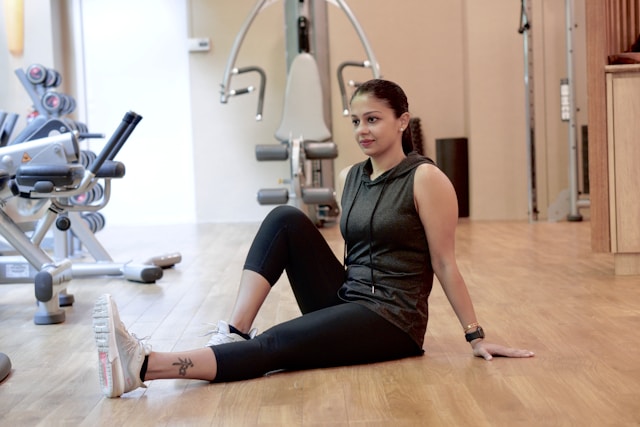Most people follow the no pain, no gain principle regarding workouts. This is not the right approach. Pushing through pain or ignoring the proper technique can lead to setbacks that sideline you and derail your fitness journey. The good news is, with the right approach, you can significantly minimize the risk of injury while reaping the benefits of intense workouts.
In this article, let’s discuss some injury prevention tips to safeguard your body during intense exercise. With these practical tips and strategies, we will help you develop a well-rounded and balanced approach to fitness where you don’t overdo yourself and get the maximum benefits out of your workout without injuring yourself.
Practical Tips to Safeguard Your Body During Intense Workouts
Here’s a comprehensive list of tips that you need to follow.
- Warm-Up Properly
- Gradual Progression
- Proper Technique
- Listen to Your Body
- Rest and Recovery
- Hydration and Nutrition
- Cross-Train
- Appropriate Footwear
- Use Safety Equipment
- Post-Workout Stretching
- Regular Checkups
- Balanced Workouts
- Regular Checkups
- Use Proper Equipment
- Maintain Adequate Hydration
- Balanced Nutrition
- Mindful Breathing
- Regular Massage or Foam Rolling
- Proper Warm-Up for Specific Activities
- Educate Yourself about workout injury
- Modify Intensity as Needed
- Mind-Body Connection
- Professional Guidance
- Know Your Limits
Have a look at this list of tips and see which tips you follow already and which ones you did not know about. Next, we will discuss the main tips in detail and the science behind each tip. We hope we can convince you to follow these tips by the end of this article and avoid injury during intense workouts.
Importance of Warm-Up
Before you get to the actual workout, dedicating time to a proper warm-up is essential. A brief 5-10 minutes of light cardiovascular exercise, such as jogging or jumping jacks, increases blood flow to your muscles. After this, you can stretch different muscle groups. This will help prepare or warm your body for an intense workout. This enhances flexibility and reduces the risk of pulls and injury.
Gradual Progression for Long-Term Success (150 words):
Besides warm-up before the high-intensity workout, gradually building up your workout is also essential. Rapidly increasing workout intensity or duration can lead to overexertion and injuries. Whether you’re lifting weights, running, or practicing yoga, allow your body to adapt by incrementally challenging it. This approach not only minimizes the risk of acute injuries but also prevents overuse injuries that may arise from repetitive stress on specific muscle groups. So, as they say, slow and steady wins the race!
Mastering Proper Technique
The next tip we have for you is to master proper technique. If your technique is incorrect, you won’t get any results. Also, what’s worse is that the wrong method is a recipe for disaster as it leads to strains, sprains and other severe injuries. So, master the proper technique and do not compromise your safety.
Listening to Your Body
Remember, your body communicates with you during workouts. You must pay attention to signals such as pain, discomfort, or fatigue. Ignoring these signs and pushing through can lead to injuries that may sideline your fitness journey. So, persistent pain, especially joint or sharp pain, should not be ignored. If you are overexerting your body despite these signs, you are in for some severe injury. Prioritizing Rest and Recovery
Whenever people think of working out, rest is far from their minds. However, adequate rest and recovery are a part of your workout routine. So, incorporate rest days into your schedule and get enough sleep. Apart from this rest, you can include foam rolling or massage to aid muscle recovery.
Hydration and Nutrition
We must mention diet and nutrition to discuss effective workouts and injury prevention tips. A balanced diet with sufficient protein to support muscle recovery is the secret behind effective workouts. Nutrient-rich foods provide the energy needed for intense workouts, ensuring your body operates at its best and reducing the risk of injuries related to nutritional deficiencies.
Apart from nutrition, hydration is also essential. You might be raising your eyebrow and thinking, why is that so? Let’s understand the science behind dehydration. To put it simply, dehydration can lead to fatigue and impaired performance. This increases the likelihood of accidents or mistakes during workouts. So, it would help to stay hydrated by drinking water before, during, and after your workout. With this simple routine, you will notice how your workout improves.
Cross-Training for Balanced Fitness
Another tip that beginners often ignore is cross-training. Focusing on more than one type of exercise can lead to imbalances and overuse injuries. Instead, if you go for cross-training, you will incorporate various activities into your routine, targeting different muscle groups and movement patterns. This reduces the risk of overtraining specific areas and enhances overall fitness.
Let’s understand cross-training with an example you can apply to your workout routine. Let’s say you are working on cardiovascular exercises like running. You can combine this with strength training or yoga to create a well-rounded workout routine that promotes overall health. In this way, you can minimize the risk of injuries associated with repetitive motions. Sounds easy.
Investing in Appropriate Footwear
Footwear is another critical practice that people often need to pay more attention to. Whether running, lifting weights, or participating in high-impact activities, investing in appropriate shoes can provide essential support and reduce the risk of injuries. Different activities require different types of footwear, so choose shoes that offer stability, cushioning, and support based on your workout routine. Ill-fitting or worn-out shoes can contribute to various issues, including blisters, shin splints, and joint pain. Ouch!
Post- Workout Stretching and Cool Down
Once you finish your main workout, don’t call it a day and rush out of your gym immediately. Instead, focus on cooling your body down. This is just like the warming up we did at the beginning. Your body needs to stretch to improve flexibility and reduce muscle tension, promoting recovery and preventing stiffness. If you spend 10 minutes at the end of each session, you can avoid injuries and improve your performance in future workouts. You should invest in a durable rubber mat for your post-workout stretching.
Injury prevention during intense workouts is directly linked with overall health and longevity in fitness pursuits. Make sure you listen to your body, recognize warning signs, and make informed choices during workouts. Remember, working out is both a science and an art. You will hurt and injure yourself if you don’t follow the science behind workouts. Apart from these critical tips, make sure you also incorporate preventive strategies such as regular checkups, proper equipment usage, and post-workout stretching to create a comprehensive injury prevention plan. Good luck!





